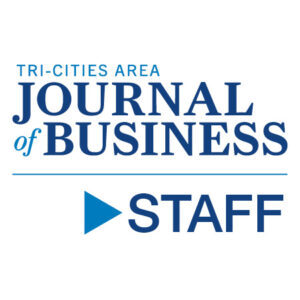
Home » Business leaders help PNNL pitch invention at national competition
Business leaders help PNNL pitch invention at national competition

February 16, 2021
A Pacific Northwest National Laboratory invention won top honors at a recent national pitch contest, thanks to its water-repellent qualities and a little help from the Tri-City business community.
Called ElastiDry Protective Coating, the material can be applied to personal protective equipment such as gloves, face shields, shoes, or protective suits, a trait that can add a layer of protection to PPE.
A panel of five judges from the Bay Area and Silicon Valley investment community chose the PNNL innovation from 10 product pitches from different national laboratories during the National Labs Accelerator Pitch Event.
PNNL won a $25,000 prize to spend toward further ElastiDry commercialization activities from the U.S. Department of Energy Office of Technology Transitions.
A team of Tri-City area business leaders helped the PNNL technical team hone its pitch to the judges.
PNNL’s Office of Technology Deployment and Outreach held an internal competition for ElastiDry and a few other PNNL-developed technologies in mid-November, choosing ElastiDry to proceed to the national stage.
Tri-City area business leaders, including entrepreneurs and representatives of the Tri-City Development Council, listened to the presentations and offered suggestions.
“It was valuable to hear from business leaders in the community,” said PNNL materials scientist Curtis Larimer, who led the research team to develop ElastiDry. “They suggested presenting more detail on the market I was targeting. They also said to know your audience and to speak to the judges as business investors, not technical people. I incorporated both of those tips into my video presentation.”
PNNL is seeking a private-sector partner to bring ElastiDry to market. At the same time, PNNL recently launched a new program through which others can get evaluation samples through a research-use agreement and a modest fee.
Larimer led the nearly three-year effort to develop the superhydrophobic material to develop ElastiDry.
To create the new material, the team experimented with mixtures containing hydrophobic silica, a microscopic particle derived from sand that’s a common ingredient in a variety of products, including paints, plastics and coatings.
The winning mixture proved super repellent when applied to a latex glove and – to the researchers’ surprise – even more water repellent when stretched.
In his presentation to the judges, Larimer emphasized the potential application for surgical gloves, noting that it could prove to be lifesaving in thwarting diseases, such as Covid-19, that can be transmitted by bodily fluids.
“Startups must be laser-focused on getting a product into the marketplace,” Larimer said. “So even though ElastiDry can be used in multiple applications, I had to narrow the scope. For this pitch, it was surgical gloves.”
Larimer also credited PNNL Commercialization Manager Allan Tuan for promoting ElastiDry as a candidate for the national competition and efforts to bring the product to market.
“PNNL’s tech transfer team does really important work,” Larimer said. “The technical staff at a national lab can’t really afford to spend the time that’s needed to get technologies from the lab bench to the real world. As scientists, it’s crucial that we have this group of talented people to step in and carry the technology for the critical last mile – to market.”
After winning the internal PNNL competition, Larimer created and refined a 10-minute video before submitting it to the one-day competition, held as a Zoom webinar.
The UC Davis Institute for Innovation and Entrepreneurship presented the accelerator pitch event in December in partnership with the national labs.
With a new year ahead, and the award in hand, Larimer anticipates continued PNNL promotion and refinement for ElastiDry.
“We’re going to spend the first part of 2021 reaching out and securing a commercial partner,” he said. “On the research side, we’re going to continue making improvements and modifications. We have plans for improvements to the material’s durability and functionality, and for additional intellectual property creation.”
Local News Health Care
KEYWORDS february 2021





